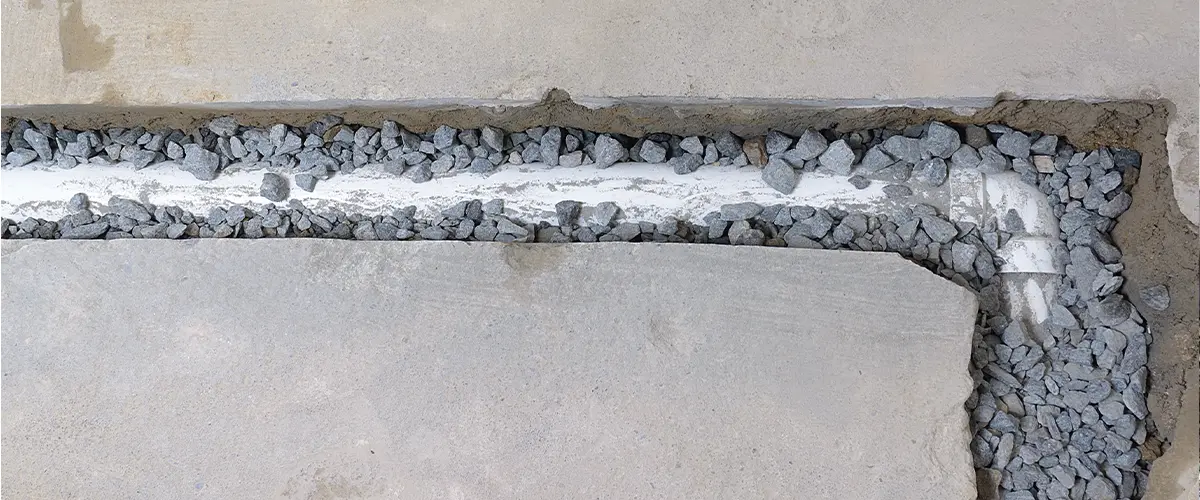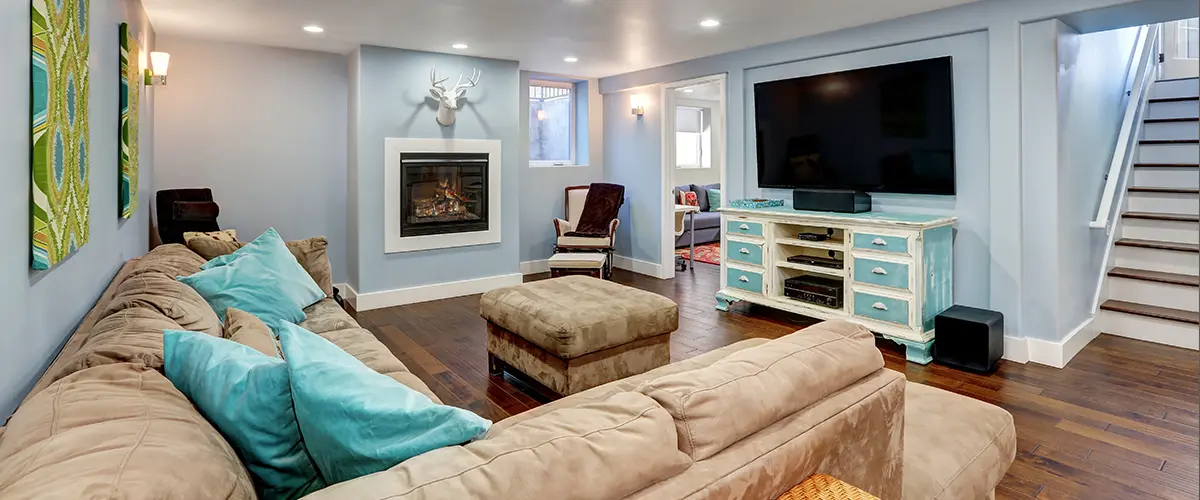Types Of Basement Drainage Systems In Hyattsville
Dealing with a wet basement can be frustrating for many homeowners. A key fact to remember is that an effective drainage system can help solve this issue.
This article will guide you through different types of basement drainage systems available in Hyattsville, showing how they work to keep your basement dry.
Keep reading to find the perfect solution for your home.

Key Takeaways
When selecting the best flooring for your basement laundry room in Hyattsville, it’s essential to choose a material that can withstand humidity and frequent use without sacrificing style.
Discover the ideal options that offer both functionality and aesthetic appeal, ensuring your laundry space is as practical as it is pleasing to the eye.
- Different basement drainage systems like French drains, curtain drains, channel or trench drains, and standard floor drains help keep your home safe from water damage.
- Sump pits and sump pumps play a key role in removing accumulated water from your basement, preventing flooding and moisture issues.
- Exterior perimeter drains prevent water from seeping into basements by redirecting groundwater away from the foundation.
- To choose the right drainage system for your basement, consider the layout of your space, sources of water, and how severe the moisture problem is.
- Consulting with a professional can provide personalized advice to select an effective solution that suits your specific needs.
Types of Basement Drainage Systems
French Drain
A French drain is a popular solution for redirecting excess water away from your home’s foundation. It involves digging a trench around the perimeter of your basement or problem area, laying down a perforated pipe, and covering it with gravel.
This setup allows water to flow through the gravel and into the pipe, diverting it safely away from your house.
Installing this system can protect your basement walls and floor from water damage. It works effectively in various types of soil, including clay-rich soil, by collecting groundwater before it reaches your foundation.
Homeowners find French drains especially helpful in areas prone to heavy rains or where hydrostatic pressure is a concern.
Curtain Drain
Moving from the French Drain, a Curtain Drain also plays a crucial role in managing excess moisture around your home. This type of drainage system is perfect for stopping surface water before it hits your foundation walls.
Crews install it shallowly beneath the ground to intercept water moving towards your house and redirect it away. It consists of a perforated pipe wrapped in fabric to prevent clogging with sediment.
Curtain Drains are effective in areas with heavy rainfall or clay-rich soil where water tends to pool on the surface. They help protect your basement from becoming wet by diverting water before it can seep through foundation cracks or basement windows.
Easy to conceal, these drains blend into your landscape without being an eyesore. Plus, they save you from dealing with mold growth and structural damage caused by unchecked moisture accumulation around your home’s base.
Channel or Trench Drain
A channel or trench drain acts like a gutter for your basement floor. This system involves creating a narrow trench along the perimeter of the basement or across it to catch water that seeps in.
Workers then cover this trench with grating, making it blend with the floor while still capturing any water leakage. It’s an effective way to manage water and divert it away from your foundation, preventing damage.
They install plastic pipes within these trenches, guiding the collected water toward a collection pit or directly outside. This ensures standing water doesn’t stay near your foundation where it can cause harm.
For homes in areas prone to heavy rainfalls or rising groundwater, installing a channel or trench drain might be the right solution to keep basements dry and safe from flood issues.
Standard Floor Drain
Transitioning from channel or trench drain to standard floor drain, the latter is a common feature in many basements. It is designed to prevent water buildup and flooding by allowing excess water to flow into the drainage system through a grated opening.
Installed in the lowest points of the basement floor, it effectively eliminates standing water and helps keep your basement dry.
The installation of a standard floor drain involves creating an opening in the concrete and connecting it to a drainage pipe that carries water away from your home’s foundation.
During heavy rainfall or plumbing mishaps, this essential component ensures efficient water removal, safeguarding your basement from potential damage and moisture-related issues.
Additional Types of Basement Drainage Systems
Sump Pit and Sump Pump
Sump pits and sump pumps are essential for preventing water from accumulating in your basement. The sump pit collects water that seeps into the basement, while the sump pump automatically removes this water and directs it away from the foundation through a discharge pipe.
Sump pumps are especially crucial in areas with heavy rainfall or homes located in areas with high groundwater levels to prevent flooding and moisture issues.
Regular maintenance of sump pumps is important to ensure they function properly when needed, such as checking for debris and testing the pump regularly to avoid any surprises during heavy rain or power outages.
These systems need periodic checks on their functioning due to potential wear out; ensuring they remain operational guarantees protection against water intrusion.
If you encounter difficulty, consider seeking expert advice for efficient solutions tailored to your specific needs.
Exterior Perimeter Drain
The exterior perimeter drain, also known as a French drain, helps keep water away from the foundation by collecting and redirecting groundwater. It consists of a trench filled with gravel and a perforated pipe that captures excess water and moves it away from the house.
This system effectively prevents moisture from seeping into basements through walls or floors. Installing an exterior perimeter drain is especially beneficial for homeowners dealing with clay-rich soil, heavy rainfall, or overflowing gutters.
Therefore, it is crucial to consider this solution when addressing basement waterproofing and foundation drainage systems.

Leading Manufacturers of Drainage Systems
When addressing basement water issues, choosing the right manufacturer for your drainage system is paramount. The quality of your system directly impacts the effectiveness of water management around your home.
Below are some of the top manufacturers renowned for their reliability and innovative solutions.
These manufacturers stand out in the industry for their commitment to quality, innovation, and customer satisfaction. When selecting a drainage system, considering products from these reputable companies can ensure a long-term solution to basement and foundation water issues.
Choosing the Right Basement Drainage System
Select a drainage system that suits your basement layout and water sources, evaluate the extent of moisture issues, and seek professional advice for tailored solutions.
Learn more on choosing the right drainage system in our blog!
Consider the layout of your basement and the potential sources of water
Examine your basement layout and potential water sources. Look for areas where water tends to accumulate, such as near water heaters or exterior walls.
Identify any existing plumbing systems and the type of soil around your home, especially if it’s clay-rich, which can impact drainage.
Assess how groundwater collects around your basement, as this will inform the most effective drainage system for your needs.
When choosing a basement drainage system, understanding these factors is crucial in addressing moisture issues effectively. Next, we’ll delve into determining the severity of your moisture issue.
Determine the severity of your moisture issue
Assess the seriousness of your moisture problem. Look for visible signs such as water stains and mold growth. Consider if the issue is occasional or persistent, affecting just a small area or spreading throughout the basement.
Take note of any musty odors or dampness in the air indicating high humidity levels. Evaluate how these factors impact your daily life and property value.
Examine the extent of damage caused by the moisture. Check for cracks in the walls and floor, rotting wood, and rust on metal surfaces like appliances or support beams.
Observe if there’s standing water after heavy rain or snow melts, as this could indicate poor drainage.
Consult with a professional for the best solution for your specific basement needs
Before making any decisions about your basement drainage system, it’s important to consult with a professional who can assess your unique situation.
Professionals can provide insights and recommendations specific to your basement layout, the severity of moisture issues, and potential sources of water.
With their hands-on experience and expertise, they can help you choose the most effective solution for redirecting water away from your basement and preventing future damage.
Don’t hesitate to reach out to an expert for personalized guidance on selecting the best drainage system for your home.

FAQs
Let Our Team of Experts Lead Your Project To Success
Remove uncertainty of the equation and choose to have professionals work on your project. This will not only ensure your project’s successful completion but the peace of mind that you invested in quality craftsmanship that will last a long time.
Contact Capstone Waterproofing Solutions at (202) 389-9121 and get a free quote for your project!
